#SecurityScan 22: Himachal Economy, explosion & gunshots in Kabul hotel by Chinese and more
India has helped by deploying its Military Training Team (IMTRAT) in Bhutan to train the Bhutanese security forces in 1961 and since then it has been providing security for the country.
Total Views |
This article is a summary of important events that have taken place in last one week affecting, India's national security.
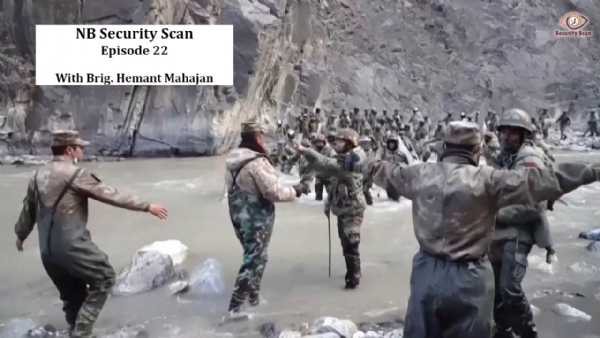
INTERNAL SECURITY
Human Security-Vulnerable workers-Need to ensure dignified rehabilitation of sewer cleaners
The Centre has informed the Lok Sabha that 400 people have died across the country during hazardous cleaning of sewers and septic tanks since 2017. This year, 48 such deaths have been reported so far; 49 were recorded in 2021.
Despite being most deserving of the benefits of reservation, these underprivileged people helplessly watch their children being deprived of academic and employment opportunities by the wards of well-heeled bureaucrats and politicians. No wonder their one generation after another has to wade through the muck.
The authorities should explore long-term solutions, such as mechanised cleaning operations, so that the workers and their families can escape the hell of the sewers and lead respectable lives.
Nuke plants are 'protected' from intrusions
Our nuclear plants are well protected from all kinds of intrusions including the cyber attacks. The minister said the government has entered into IGAs with Russian Federation for setting up Kudankulam Nuclear Power Projects comprising six units of 1000 MW each.
ECONOMIC SECURITY
The economic cost of India’s subsidy
Spending has increased in response to extraordinary crises. But high subsidy bills also entail costs, create market distortion. Direct benefit transfers are the way forward
The government received the Lok Sabha’s nod on Wednesday to spend an additional Rs 2,14,580.88 crore towards subsidies on the 3Fs — food, fertiliser and fuel — in the current fiscal. Assuming no further batches of supplementary demands for grants, it will take the total expenditure in 2022-23 to Rs 5,32,446.79 crore: Food (Rs 2,87,179.34 crore), fertiliser (Rs 2,14,511.27 crore) and petroleum (Rs 30,756.18 crore). That would be the second highest outgo on major subsidies after the Rs 7,06,006.53 crore in 2020-21.
This time’s overshooting is entirely on account of current obligations, linked to the government’s decision to cushion consumers and farmers from the ravages of Covid-19 and the Russia-Ukraine war.
Even on petrol and diesel, the government softened the blow by not allowing retail prices to go up since early-April this year.
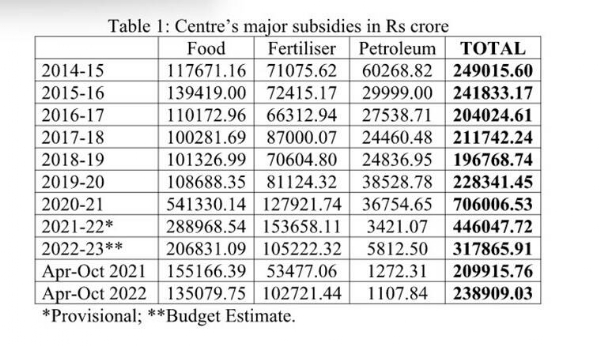
The Rs 5,32,446.79 crore subsidy bill on the 3Fs (food,fertilizer,fuel) will consume nearly a quarter of the Centre’s budgeted revenue receipts for this fiscal. The problem lies in the market distortions created and incurred excessively even in normal years. The government has addressed this substantially in fossil fuels, which are today, net taxed than subsidised. But this does not apply to fertiliser and food.
By replacing food and fertiliser subsidy with targeted direct benefit transfers, would be the way forward.
Disaster For Himachal Economy Back to Old Pension Scheme
With the fresh Chief Minister of Himachal Pradesh, Sukhvinder Singh Sukhu, reiterating that the Old Pension Scheme (OPS) will be restored by the newly elected Congress-led government, the State would now become the fourth to do so. It is no surprise that the promise of the return of OPS boosted the beleaguered party as government employees and retirees form a significant portion of the hilly State’s electorate.
With a greying population, the burden of payments will fall on future generations. The NPS, that has been in place and which allows employees to contribute to their pension corpus from their salaries with matching contribution from the government, is more robust as this corpus is invested through Pension Fund Managers and eases the State’s burden.
The NPS has built a substantial corpus and subscriber base over time. The Congress-led UPA government had indeed taken forward the pension reforms by the previous NDA regime and this is how the NPS has become relevant over the years.
Breaking a consensus on pension reforms and reverting to OPS amounts to an imprudent option as it will only benefit organised government sector employees, increase the fiscal burden of carrying these payments and take up a significant portion of the State’s budget, thereby curtailing its outlays on general welfare as a whole.
EXTERNAL SECURITY
COUNTERING CHINESE MUTI DOMAIN WAR
Nepal, India to hold joint military training exercise
"Indian Army troops arrived today in Saljhandi, Nepal for the 16th Joint India-Nepal Military Ex #SURYAKIRAN. The exercises are for the exchange of professional experience & cementing the friendship between two armies.
Indian Naval chief Admiral Kumar on Sri Lanka visit to strengthen bilateral maritime ties
Admiral Kumar will be the Chief Guest at the passing out parade of Naval and Maritime Academy at Trincomalee on December 15. Admiral Kumar's visit follows the Indian Navy's supply of a maritime reconnaissance aircraft to Sri Lanka Air Force in August 2022 to augment its maritime capabilities.
Major Air exercise covering the Northeastern
The last of the 36 IAF Rafale aircraft landed in India on Thursday. The jets reached India after a quick enroute sip from a UAE Air Force tanker. Jet joined the second Rafale squadron in Hasimara .The IAF launched a major exercise covering the Northeastern region amid a fresh spike of border tension with China.
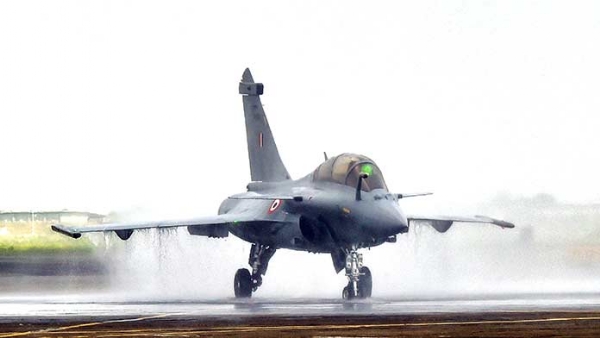
To a query on the manufacturing status of Rafale and Falcon 2000 in the DRAL manufacturing plant, France said that 5 pieces of Rafale are manufactured in Nagpur and then sent to the France assembly line to be assembled in all the Rafale jets, not just the Indian ones. As regards to the manufacturing of Falcon 2000 jets, DRAL is making different segments of Falcon 2000 jets and they are sent to France to be integrated with the assembly line.
Explosion, gunshots in Kabul hotel frequented by Chinese visitors
The militant Islamic State group has claimed responsibility for a coordinated attack on a hotel in Afghanistan's capital that left three assailants dead and at least two of the hotel guests injured as they tried to escape by jumping out from a window.
This was a hotel owned by the Chinese. The Chinese government now has warned all its citizens to live Afghanistan because it is very dangerous.
So much for Chinese investments in Afghanistan and Chinese trying to exploit natural resources in Afghanistan. The Taliban will exploit Chinese more than the Chinese exploitation of Afghanistan.
Six Pakistanis, one Afghan soldier killed in cross-border clash
The Pakistan army said Afghan border forces had opened "unprovoked and indiscriminate fire of heavy weapons including artillery/mortar onto the civilian population" at the Chaman border crossing, which links Pakistan's western Balochistan province with Afghanistan's southern Kandahar province on 12 Dec.
Fresh clashes erupted between Afghan, Pakistani border forces on 14 Dec. Previously, cross-border shelling and gunfire killed eight Pakistani civilians and one Afghan soldier on Sunday near the same crossing, which connects Pakistan's southwestern province of Balochistan with the southern Afghan province of Kandahar.
The Pakistan Afghanistan border is extremely active and lot of violence is taking place on the Durand line. Attacks by TTP continue to take place inside Pakistan from the safe hideouts in Afghanistan.
Corruption runs deep in Pakistan Army
General Bajwa family assets as declared are 12.7 billion dollars as per official records, while his wife's assets are more than 2.2 billion dollars. Chinese influence-Pak reliance on Beijing
A new study has concluded that Pakistan is the country most influenced by China. The China Index — a cross-regional project of DoubleThink Lab, a Taiwan-based research organisation — ranks 82 countries as per varying degrees of dependence on Beijing. Pakistan is followed by Cambodia (second) and Singapore (third), while Central Asian nations Kyrgyzstan and Tajikistan also figure in the top 10. The index focuses on nine domains to assess China’s sway around the world — academia, domestic politics, economy, foreign policy, military cooperation, law enforcement, media, society and technology.
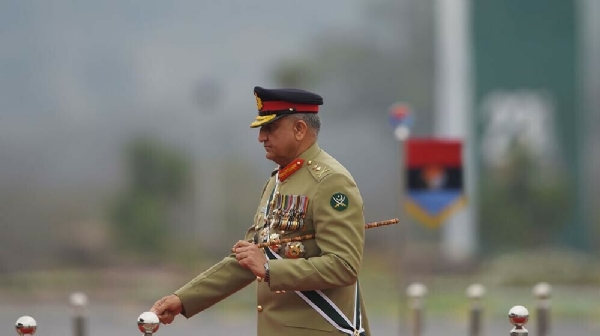
Cash-strapped Pakistan’s heavy reliance on China for financial support is no secret. According to an IMF report, about 30 per cent of Pakistan’s foreign debt is owed to China. Chinese fiscal assistance is higher than both Pakistan’s IMF debt and the amount given by the World Bank or the Asian Development Bank. China has been ‘rewarding’ its close ally by repeatedly blocking India-US proposals at the United Nations to proscribe Pakistan-based terrorists.
China's economic investment in Pakistan is not such a bad thing, as Chinas 17 billion + CPEC corridor has given them no return up till now and is unlikely to be economically viable even in next 15 to 20 years.
Kalyani Rafael Advanced Systems MRSAM kit for Indian armed forces
The kit is part of the MRSAM Air Defence Missile jointly developed by Rafael Advanced Defence Systems Ltd and DRDO and manufactured in collaboration with Indian industry comprising both private and public sector players including MSMEs.
Another feather in the cap of make in India Atma Nirbhar Bharat.
Amid border tensions with China, India successfully test-fires Agni-V ballistic missile
Nuclear-capable missile with range of over 5,000 km will give significant boost to country’s strategic deterrence.
India has been steadily enhancing its overall military might in the last couple of years.It has carried out successful tests of a number of missiles during the period.
In May, the extended range version of the BrahMos supersonic cruise missile was test-fired from a Sukhoi fighter jet.It was the first launch of the extended range version of the BrahMos missile from a Su-30MKI aircraft.
An anti-ship version of the BrahMos supersonic cruise missile was successfully test-fired jointly by the Indian Navy and the Andaman and Nicobar Command in April.
India-China LAC face-off: Provocation in Arunachal
The vigilant Indian troops thwarted an attempt by the Chinese PLA to unilaterally change the status quo in the Yangtse area of Arunachal Pradesh’s Tawang sector on December 9. Defence Minister Rajnath Singh informed the Lok Sabha on Tuesday that Chinese soldiers retreated due to the timely intervention of Indian commanders. The Tawang confrontation is the first major clash between Indian and Chinese troops since the one near Rinchen La in eastern Ladakh in August 2020. In a bid to downplay the latest incident, the Chinese Foreign Ministry has said that the border situation is ‘generally stable’, adding that the two sides have maintained unobstructed dialogue on the border issue through diplomatic and military channels.
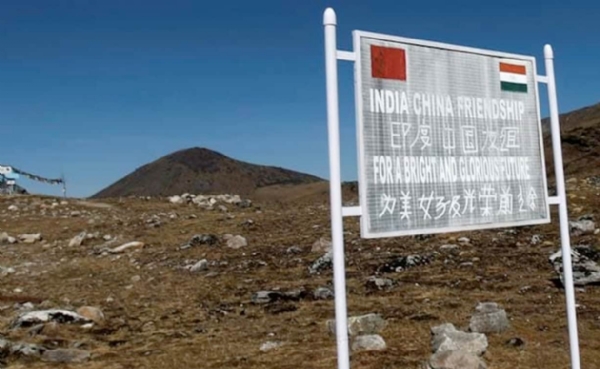
India needs to take these misadventures seriously not only in terms of national security concerns but also in view of its overdependence on Chinese imports.
The PLA seems to be perfecting its street-gang style of fighting along the LAC and has equipped its border troops with spiked clubs and tasers to pulverise the opponent in a conflict which precludes the use of firearms.
The Galwan clash and the resultant casualties highlighted the lethality of such improvisations for physical fights. However, this time the Indian troops were well prepared both in terms of pre-empting the enemy build-up by reinforcing their own threatened position and being armed with the right type of equipment. The efficacy of tasers against enemy personnel in moisture-affected winter clothing at these heights can be fatal.
While the focus is on harnessing technology for indigenisation of big-ticket defence equipment and weapon systems, efforts also have to be made for equipping the soldiers on these icy heights with riot-control gear. This kind of inventory becomes important when faced with an adversary who will unscrupulously attempt bullying tactics and fisticuffs in scuffles for seizing control of areas.
China sees India as the sole challenger to its regional domination in Asia, which it aspires for as a prelude to global superpower status. The border standoff in eastern Ladakh with the PLA, which began in mid-2020, has entered a stalemate phase, with the latest round of talks achieving little progress and the Indian Army formations committed in the bleak and hostile terrain for the long haul.
PLA will endeavour for a more aggressive approach in gaining positions of advantage anywhere along our northern borders. At the same time, China will continue to stress on delinking border scuffles from overall bilateral relations, while India will emphasise on a holistic approach with peace on the borders as a prerequisite. The on-ground implication for the Indian Army is increased year-round deployment in hostile terrain and weather.
China, apart from maintaining a belligerent military posture, would amply harness the media and look for every opportunity to keep India in a reactive mode. Being prepared on all counts, is the only way to tackle this threat to national security.
China is India’s second largest trading partner (after the US), with a huge trade deficit of $73.71 billion. India’s assertion that resolving the boundary dispute is a prerequisite for normalisation of bilateral ties is not matched by the constant growth in India-China trade, which had peaked at $115.83 billion in 2021-22. The ‘Make in India’ initiative needs a big push to put the country on a firm footing to resist Chinese machinations.
How to cut import dependence on China
The rise in these imports is not necessarily a negative development. The rise in the import of electronic components, computer hardware and peripherals and components for phones is resulting from India’s attempt to become a digitally empowered society with a burgeoning knowledge economy.
The rise in imports is the result of India’s attempt to boost its manufacturing economy. The drug intermediates and bulk drugs that go into these formulations are mostly imported from China. Both in the case of electronics and pharmaceuticals, reducing import dependence on China can only be done in the medium or long run and has to be part of an overall policy.
In non-essentials, the government has met with some success in curbing the import of toys. Now, it seeks to turn its attention to electric fans and smart meters. It is using a somewhat novel tool to do this — by issuing quality-control orders.
So how can India square the circle? A research project undertaken by the Indian Institute of Management, Indore, and the Wharton School of the University of Pennsylvania, at the behest of the NITI Aayog, has thrown up some ideas. A key one is for India to play a more active role on multilateral economic platforms such as ASEAN (Southeast Asian countries), MERCOSUR (trade bloc of South American nations) and NAFTA (free trade agreement between North American countries).
The study has also divided 900 products imported from China into four categories. These are high-tech products, electronics, commodity technical products and commodities. The first two categories of products, whose manufacturing requires advanced efforts that take time to shape up, can be imported from alternative global suppliers for three years. The next two categories which incorporate basic technology and are traded on the basis of price differentiation can be imported only for six months.
As to how the government should change its way of working. The Central and state governments should get together to achieve a quantum leap in improving the ease of doing business.
China threatens Bhutan for aligning with India
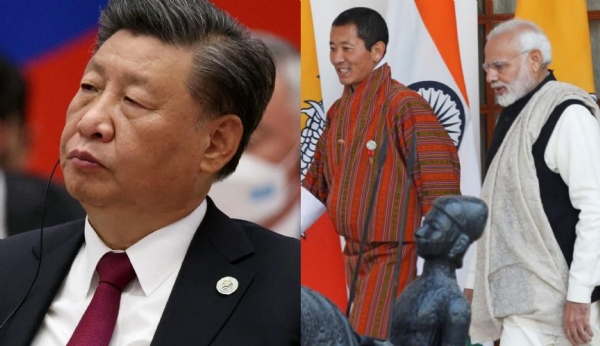
China's act of flaring up the territorial disputes can be the means to 'punish' Bhutan for aligning with India as Beijing assumed that Thimphu's foreign policy for their country is influenced by New Delhi's dominance and control.
India has helped by deploying its Military Training Team (IMTRAT) in Bhutan to train the Bhutanese security forces in 1961 and since then it has been providing security for the country. Recently, the Doklam standoff between Indian and Chinese forces in 2017 has made the security matter even more important and calls for even better coordination and partnership between Indian and Bhutanese forces to secure the strategic areas.
India has provided significant assistance in wideranging areas including hydropower, trade, education, and socio-economic development. India has been a market for Bhutan's exports providing its revenue by consuming hydroelectricity, semi-finished products, ferrosilicon, and dolomite. Epardafas.com reported that the major Indo-Bhutan relations have been related to Hydroelectricity generation as both have committed to developing a 10,000-megawatt hydroelectricity project in Bhutan. Although the development of the 720 MW Mangdechhu hydropower project is an achievement. This has propelled yet another project 600 MW Kholongchhu for hydroelectricity. This is to gather surplus hydroelectricity from Bhutan and export it to India which will generate employment and revenue for Bhutan.
---



